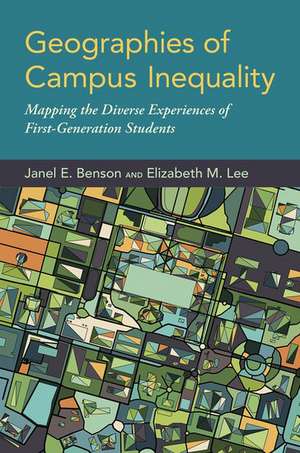Geographies of Campus Inequality: Mapping the Diverse Experiences of First-Generation Students
Autor Janel E. Benson, Elizabeth M. Leeen Limba Engleză Hardback – 22 sep 2020
Preț: 299.58 lei
Nou
Puncte Express: 449
Preț estimativ în valută:
57.33€ • 60.00$ • 47.71£
57.33€ • 60.00$ • 47.71£
Carte disponibilă
Livrare economică 10-24 martie
Preluare comenzi: 021 569.72.76
Specificații
ISBN-13: 9780190848156
ISBN-10: 0190848154
Pagini: 216
Dimensiuni: 155 x 236 x 23 mm
Greutate: 0.45 kg
Editura: Oxford University Press
Colecția OUP USA
Locul publicării:New York, United States
ISBN-10: 0190848154
Pagini: 216
Dimensiuni: 155 x 236 x 23 mm
Greutate: 0.45 kg
Editura: Oxford University Press
Colecția OUP USA
Locul publicării:New York, United States
Recenzii
Geographies of Campus Inequality is another great example of empirical work that needs to be taken seriously if selective colleges really want to better meet the needs of a diverse group of first-generation college students.
This book shines when it demonstrates that "first-generation status is an intersectional category, more or less meaningful for individual students, and intertwined with other identities such as race, gender, and income" (p. 173). We see that without accounting for intersecting identities, the FG [First Generation] category could end up accounting for no students' experiences or outcomes. The observation that organizational structures shape the possibilities for how students will perceive and navigate college is an important one. That is, what it means to be FG, in terms of experiences, perceptions, and outcomes, comes not only from the students themselves, but also is "based on the available social world, the dominant social structure, and the ways in which they have been invited into campus with particular opportunities and resources" (p. 169).
Overall, Geographies of Campus Inequality is an excellent resource reviewing the intersections of first-generation students' identities, backgrounds, and experiences, particularly within the lesser-reviewed area of selective-admission institutions. While this work focuses on selective institutions, there remains broad applicability to other types of institutions of higher education as well. The "geographies" construct is very useful in making sense of the diversity within the first-generation cohort. The care that Benson and Lee take to approach first-generation experiences from an institution-first perspective instead of a student-deficit-oriented perspective is refreshing, providing realistic and concrete recommendations that institutions may consider in their recruitment and education of first-generation and low-income students.
... this thoroughgoing analysis should be of considerable value to college counseling personnel hoping to better serve their resident students and promote more enhanced adjustments at their colleges.
This book shines when it demonstrates that "first-generation status is an intersectional category, more or less meaningful for individual students, and intertwined with other identities such as race, gender, and income" (p. 173). We see that without accounting for intersecting identities, the FG [First Generation] category could end up accounting for no students' experiences or outcomes. The observation that organizational structures shape the possibilities for how students will perceive and navigate college is an important one. That is, what it means to be FG, in terms of experiences, perceptions, and outcomes, comes not only from the students themselves, but also is "based on the available social world, the dominant social structure, and the ways in which they have been invited into campus with particular opportunities and resources" (p. 169).
Overall, Geographies of Campus Inequality is an excellent resource reviewing the intersections of first-generation students' identities, backgrounds, and experiences, particularly within the lesser-reviewed area of selective-admission institutions. While this work focuses on selective institutions, there remains broad applicability to other types of institutions of higher education as well. The "geographies" construct is very useful in making sense of the diversity within the first-generation cohort. The care that Benson and Lee take to approach first-generation experiences from an institution-first perspective instead of a student-deficit-oriented perspective is refreshing, providing realistic and concrete recommendations that institutions may consider in their recruitment and education of first-generation and low-income students.
... this thoroughgoing analysis should be of considerable value to college counseling personnel hoping to better serve their resident students and promote more enhanced adjustments at their colleges.
Notă biografică
Janel E. Benson is Associate Professor of Sociology at Colgate University. Her research investigates sources of risk and resiliency in the transition from early adolescence to young adulthood to understand how contexts of development in early life shape identity, health, and social mobility. As a first-generation student, she is dedicated to mentoring other students who are first in their families to attend college through the A Better Chance program in Fayetteville-Manlius.Elizabeth M. Lee is Assistant Professor of Sociology at Saint Joseph's University. Her research examines class inequality, primarily within higher education settings. Much of her research focuses on how low-income, first-generation, and/or working-class (LIFGWC) college students at selective campuses manage class inequality among their peers through day to day interactions and relationships. Other work focuses on faculty members from LIFGWC backgrounds and on how students interact with their campus structures.
